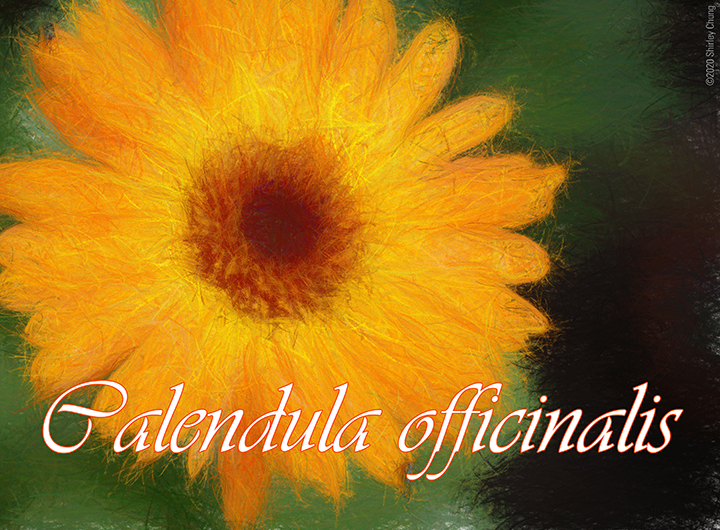
Calendula officinalis
Calendula officinalis are sometimes known as “pot marigold” (of the genus Tagetes and the same family Asteraceae). Don’t get confused! “Pot marigold” are different from other garden marigolds. Calendula officinalis range from bright yellow to deep orange.
Habitat/Growing Information.
Calendula officinalis (considered an herb) love the sun. You can grow them indoors or outside (after the last frost). It takes 45-60 days for the plant to mature from a seed. Their blooms are usually 2.5-4 inches in diameter and the plants are 18-24 inches tall. They like full sun but can also grow in partial shade in garden beds or containers. Be sure to allow adequate space between plants. C. officinalis (a perennial) grows in USDA hardiness zones 7-11. However, it is often grown as an annual in zones 2-11.
Parts utilized.
The flowers and leaves (spicy) are both edible. Sometimes they are added to butter (for color) or soups. They may also be used in salves and lotions.
Properties.
Calendula officinalis has been used for wounds, burns, and rashes. If harvesting for the oils, be sure to clip the whole bud as the oils are mostly in the involucres (bract, whorl). C. officinalis has been used for: antioxidant; antibacterial; anti-fungal; antiseptic; anti-HIV; antiviral; anti-edematous; fevers; gastritis/gastro-protective; insecticidal; heart rate decreasse; cardio-protective; hypotension; jaundice; rheumatism; mucous membrane inflammations; and vomiting (Alnuqaydan, Lenehan, Hughes, & Sanderson, 2015; Baskaran, Marigold, Marigold, English, & German, 2017; Chaleshtori, Kachoie, & Pirbalouti , 2016; Miguel et al., 2016).
The essential oil of C. officinalis was found to have an effect against B. subtilis, E.coli, S. aureus, P. aeruginosa, K. aerogenes, E. faecalis, K. pneumonia, and C. albicans (Chaleshtori et al., 2016; Baskaran et al., 2017 ). A tincture preparation of C. officinalis had suppressive effects in vitro against herpes simplex, influenza A2, and influenza APR-8 (Baskaran et al., 2017). A preparation of chloroform extract of C. officinalis had inhibitory effects on HIV-1 replication and HIV-1 reverse transcriptase (Baskaran et al., 2017). Chaleshtori et al. (2016) noted that the bioactive compounds in C. officinalis were: “triterpenoid like calendulaglycoside, triterpenoid saponin like faradiol, asorhamnetin3-O-neohesperidoside, quercetin and isorhamnetin” (p. 520).
Calendula officinalis has active compounds: steroids, terpenoids, triterpenoids, phenolic acids, flavonoids, and caretenoids (Miguel et al., 2016). Oxalic, citric, and fumaric acids were found in C. officinalis along with alpha, beta, and gamma tocepherols–about 23 mg of tocepherols per 100 g of plant dry weight (Miguel et al., 2016).
References
- https://www.planetnatural.com/growing-calendula/
- http://www.gardening.cornell.edu/homegardening/sceneff01.html
- http://hort.ufl.edu/database/documents/pdf/shrub_fact_sheets/caloffa.pdf
- https://www.thespruce.com/growing-and-using-calendula-1402626
- https://chestnutherbs.com/calendula-sunshine-incarnate-an-edible-and-medicinal-flower/
- https://bibliotecadigital.ipb.pt/bitstream/10198/13571/3/342.pdf
- https://youtu.be/CVc7pRkUpgo
- https://youtu.be/w46LHwBz4_4
- https://youtu.be/KNRsXuFpVrw
- https://youtu.be/o5quSDg1LPo
Alnuqaydan, A. M., Lenehan, C. E., Hughes, R. R., & Sanderson, B. J. (2015). Extracts from Calendula officinalis offer in vitro protection against H2O2 induced oxidative stress cell killing of human skin cells. Phytotherapy research, 29(1), 120-124.
Baskaran, K., Marigold, C., Marigold, G., English, P. M., & German, B. (2017). Pharmacological Activities of Calendula officinalis. International Journal of Science and Research, 6(5), 43-47.
Chaleshtori, S. H., Kachoie, M. A., & Pirbalouti, A. G. (2016). Phytochemical analysis and antibacterial effects of Calendula officinalis essential oil. Biosciences and Biotechnology Research Communication, 9(3), 517-522.
Miguel, M., Barros, L., Pereira, C., Calhelha, R. C., Garcia, P. A., Castro, M. Á., … & Ferreira, I. C. (2016). Chemical characterization and bioactive properties of two aromatic plants: Calendula officinalis L.(flowers) and Mentha cervina L.(leaves). Food & function, 7(5), 2223-2232.